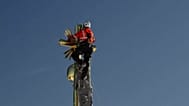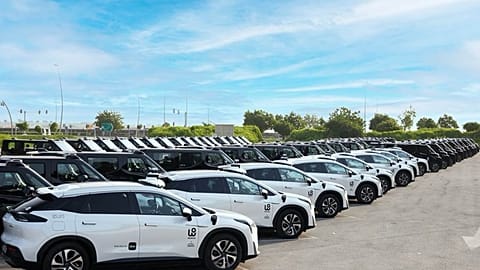Designs for a new hydrogen-powered jet could begin a new era of hypersonic flight that would cut journey times around the globe by air to a few hours.
The last aircraft to manage the feat was the Concorde, the supersonic result of Anglo-French engineering.
In its heyday, it crossed the Atlantic in record time in around 3.5 hours, flying at a speed of over 2,100 km/h.
But a Swiss start-up is looking to cut the current journey time from Paris to New York down from 8 hours to just an hour and a half - with its hypersonic, hydrogen-powered passenger jet.
While other companies are dabbling again with supersonic flight, Destinus aims to build the first commercial hydrogen-powered aircraft that can travel at five times the speed of sound and at altitudes of more than 33 km (over 100,000 ft).
The company has been testing its prototype aircraft for the past couple of years, announcing successful test flights of its second prototype - Eiger - at the end of 2022.
"The prototypes look different from the final product because the final product has very advanced propulsion technology," Bart Van Hove, Destinus' head of advanced studies, said during this year's Paris Air Show at Le Bourget.
"It has different types of engines, turbo jets, and ramjet, all hydrogen-powered and all hydrogen-cooled. So that goes with a particular vehicle configuration as shape, as you see in our vision, of a plane that grabs a huge amount of air and there is a central duct and that splits into various engine ducts.
"This is not the case on the prototype. It's more of a classical configuration because we go step by step".
Spanish government investment
In April, the company received a boast in investment, announcing its participation in a programme run by Spain’s Ministry of Science, part of the Spanish government’s plans to develop hydrogen-powered supersonic flights.
The agency overseeing the ministry's programme, the Centro para el Desarrollo Tecnológico e Industrial, selected the project as a strategic initiative under its Plan de Tecnologías Aeronáuticas (PTA).
With an overall current investment of €12 million, the project involves companies and technology centres as well as Spanish universities.
"We are delighted to have been awarded these grants, especially because they are a clear sign that Destinus is aligned with the strategic lines of Spain and Europe to advance hydrogen flight," Davide Bonetti, VP Business Development and Products for Destinus, said at the time.
"For deep tech companies like us, access to these EU recovery funds is essential to carry out advanced research and accelerate the innovation needed to be competitive on a global scale. With these grants, hydrogen-based solutions for aeronautical mobility will be one step closer to becoming a reality".
Hydrogen power is the subject of a lot of research and development, with proponents pointing to its green credentials, the main byproducts of hydrogen combustion being heat and water.
"We're trying to do the ultimate thing, which is flying people safely with hydrogen, no emissions, hypersonically. That's all over the world in four hours. Supersonically, that's just impossible," Van Hove said.
The amount of heat generated presents a design challenge, though.
Researchers at RMIT University in Melbourne recently developed 3D printed catalysts which they say can power hypersonic flight and act as a cooling agent to combat the extreme heat generated when aircraft fly five times the speed of sound, which is around 6,100 kilometres per hour (km/h).
At those speeds, future commercial airlines would be able to fly between Paris and New York in around 90 minutes.
Frankfurt to Sydney in 4 hours and 15 minutes
It also opens the opportunity to shorten travel around the global.
Flying across the world from Europe to a destination such as Australia currently takes around 20 hours in a regular passenger jet.
Destinus claims its technology will make a flight from Frankfurt to Sydney last just 4 hours 15 minutes as opposed to 20 hours, while a flight from Frankfurt to Shanghai would take 2 hours 45 minutes, eight hours shorter than that journey currently takes.
Destinus partnered with Spanish engine manufacturer ITP Aero in June 2022 to develop a hydrogen engine test facility.
The grant from the Spanish government will fund the construction of a test facility near Madrid where the air-breathing hydrogen engines will be put through their paces.
A second grant project of €15 million will fund research into aspects of liquid hydrogen-powered propulsion.
The project is part of Spain’s push to be at the forefront of developing and producing hydrogen-based mobility in a number of sectors.


















